An ability is a unique action performed by a God, distinct from Relics or Active Items. These abilities define a God’s kit and playstyle, offering various effects that shape combat and strategy. In addition to Gods, certain Jungle Monsters and Bosses, such as the ![]() Fire Giant and the
Fire Giant and the ![]() Gold Fury, possess a limited amount of abilities of their own, to a lesser extent.
Gold Fury, possess a limited amount of abilities of their own, to a lesser extent.
God Kits
Each God in SMITE 2 typically follows a standard ability structure:
-
Passive: Automatically active at the start of the match, a passive provides ongoing effects without needing to be activated. These effects often scale with level or other in-game factors and serve to define a God’s core identity.
-
Basic Abilities: Gods have three basic abilities, available starting at level 1. These are ranked up throughout the match, with each ability maxing at 5 ranks. Players unlock and level these abilities as they gain experience.
-
Ultimate Ability: A God’s most powerful ability, unlocked at level 5, and upgraded at levels 9, 13, 17 and 20. Ultimates are often game-changing and come with longer cooldowns and dramatic effects. The status of each player’s ultimate is shown on the HUD, indicating whether it''s ready, on cooldown, or not yet learned.
- Aspects: Unique enhancements that further differentiate a God’s playstyle. Aspects may modify abilities, grant additional effects, or introduce new mechanics. These features are specific to certain Gods and add another layer of strategic depth to their kits.
Note: Some Gods' Ultimates maybe classified as such for interaction purposes but function differently in practice, such as [GOD:Ullr]'s ![]() Wield Axes /
Wield Axes / ![]() Wield Bow.
Wield Bow.
Ability Components
-
Active: Requires manual input to cast, targeting a unit, location, or direction. Passive abilities never feature this component. Some abilities include a Recast, allowing a follow-up cast after the initial activation. Abilities with multiple recasts are often referred to by their sequence: First Cast, Second Cast, and Third Cast.
- Some examples are [GOD:Nemesis]'s
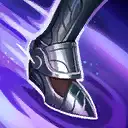 Swift Vengeance and [GOD:Susano]'s
Swift Vengeance and [GOD:Susano]'s  Storm Kata.
Storm Kata.
- Some examples are [GOD:Nemesis]'s
-
Channel: Certain abilities require the champion to channel, during which they must remain stationary or avoid specific actions for the ability to take effect. Channels can be interrupted by crowd control or by cancelling the ability. Movement-based channels can also be broken by root or grounding effects. Some channels are charged abilities, where the ability becomes more potent the longer it is channeled. Interrupted channels do not refund costs or cooldowns, though some may receive a reduced cooldown if self-interrupted.
-
Charge Up: Some abilities have a short casting period during which the champion is unable to perform other actions until the ability is executed or cancelled. Cast times prevent instantaneous activation and can only be interrupted by death.
- Some examples are [GOD:Athena]'s
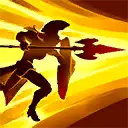 Preemptive Strike and [GOD:Odin]'s
Preemptive Strike and [GOD:Odin]'s 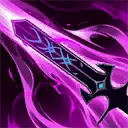 Gungnir''s Might.
Gungnir''s Might.
- Some examples are [GOD:Athena]'s
-
Charges: Certain abilities use a charge system instead of a traditional cooldown. There are two primary types:
-
Stock: Charges replenish periodically, up to a maximum. The recharge rate can be affected by Cooldown Rate.
- Some examples are [GOD:Agni]'s
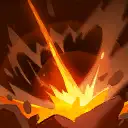 Rain Fire and [GOD:Rama]'s
Rain Fire and [GOD:Rama]'s 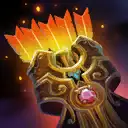 Astral Quiver
Astral Quiver
- Some examples are [GOD:Agni]'s
-
Barrage: Charges are generated upon activation and are usable for a limited duration. Any unused charges are lost when this duration ends.
- An example is [GOD:Pele]'s
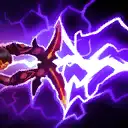 Volcanic Rush.
Volcanic Rush.
- An example is [GOD:Pele]'s
-
-
Cooldown: After being used, most abilities have a cooldown period before they can be used again. This downtime can be shortened by the Cooldown Rate stat.
-
Cost: Most abilities consume a resource such as
 mana,
mana,  health, or another unique resource. The ability cannot be cast if the champion lacks the required amount (the HUD icon will turn red when insufficient). Toggle abilities continuously consume resources until deactivated or the resource is depleted. Resourceless Gods do not have resource costs for their abilities.
health, or another unique resource. The ability cannot be cast if the champion lacks the required amount (the HUD icon will turn red when insufficient). Toggle abilities continuously consume resources until deactivated or the resource is depleted. Resourceless Gods do not have resource costs for their abilities.- Most Gods utilize mana, with a few exceptions:
- [GOD:Thanatos] utilizes
 health as a resource
health as a resource - [GOD:Yemoja] utilizes
omi as a resource
- [GOD:Bari] utilizes no resources, and is thus considered resourceless
- [GOD:Thanatos] utilizes
- Most Gods utilize mana, with a few exceptions:
-
On-Action Effects: Abilities may interact with specific actions or other abilities, creating synergy within a champion’s kit.
-
Range: Indicates the maximum distance between the caster and target for an ability to be used or to hit. Range and targeting are shown in tooltips and are visually represented when hovering over an ability icon. Some abilities, particularly ultimates, have semi-global or a global range.
- Some examples of abilities with semi-global range are [GOD:Mordred]'s
 Pursue the Weak and [GOD:Thor]'s
Pursue the Weak and [GOD:Thor]'s 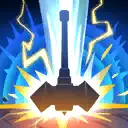 Anvil of Dawn.
Anvil of Dawn. - Some examples of abilities with global range are [GOD:NuWa]'s
 Fire Shards and [GOD:Neith]'s
Fire Shards and [GOD:Neith]'s  World Weaver.
World Weaver.
- Some examples of abilities with semi-global range are [GOD:Mordred]'s
-
Scaling: Abilities increase in potency based on certain stats gained through items or runes. This scaling allows abilities to grow stronger over the course of a match.
-
Stance-Switching: Alters a champion''s form or abilities, often providing persistent effects or temporary bonuses while disabling others. Stance-Switching is typically limited by a brief global cooldown to prevent abuse. Some stances replace a champion’s basic abilities entirely, depending on which stance is active.
- Some examples of Stance-Switching Gods are [GOD:Amaterasu], [GOD:Merlin] and [GOD:Ullr].
-
Summon: The champion can summon allied units to assist in battle, either to deal damage, provide utility, or serve other purposes.
- Some examples are [GOD:Danzaburou]'s
 Dishonest Duplication and [GOD:Vulcan]'s
Dishonest Duplication and [GOD:Vulcan]'s  Inferno Cannon.
Inferno Cannon.
- Some examples are [GOD:Danzaburou]'s
-
Toggle: Allows a champion to switch an ability on or off at will. While active, toggles apply continuous effects and consume resources. Some toggles may change the ability’s behavior or swap it for an alternate effect.
Ability Effects
Abilities can apply a wide variety of effects, typically categorized as Combat or Utility:
Combat Effects
-
Damage: Inflicts health loss on enemies.
-
Buffs: Enhance the caster or allies (e.g., increased speed, damage, or protections).
-
Debuffs: Weaken enemies (e.g., reduce damage or protections).
-
Crowd Control (CC): Special debuffs that impair enemy movement or actions (e.g., stun, root, silence).
Utility Effects
-
Mobility: Dashes, Leaps and Blinks allow repositioning, dodging, or initiating.
-
Healing: Restores health over time or instantly.
-
Shields: Absorb incoming damage before health is affected.
-
Stealth: Grants Invisibility, allowing for evasion or surprise attacks.
-
Invulnerability: Temporary immunity to damage.